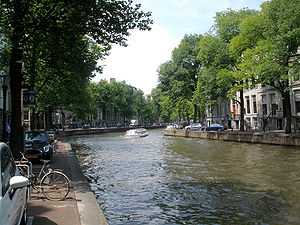Gouden Bocht
Coordinates: 52°21′56″N 4°53′26″E / 52.36556°N 4.89056°E


The Gouden Bocht ("Golden Bend") is the most prestigious part of Herengracht in Amsterdam, between Leidsestraat and Vijzelstraat.
Until 1663 Herengracht reached as far as the present Leidsegracht. From that year on, the fortifications around Amsterdam were expanded, within Herengracht, Keizersgracht and Prinsengracht were extended. The digging ended at the river Amstel within a few years. The buyers on Herengracht were encouraged to buy two lots and built double-wide mansions, and because the three canals here were laid out a little further from each other, and the lots were also deeper. On these large lots, the well-to-do placed their city-palaces with classicist facades, stuccoed ceilings, and fine gardens, once a year open to the public. In the curve, by the Nieuwe Spiegelstraat, lived Amsterdam's richest citizens, and so this part of the belt of canals was named the "Golden Bend" in recent history.
The House of the family De Neufville (1731), Herengracht 475, and Herengracht 476 are known as having the prettiest facades. Herengracht 466, on the corner of the Nieuwe Spiegelstraat was designed by Philip Vingboons and from 1858 until 1926 the office of the Dutch Trade-Society. On the other corner (Herengracht 464) is the office of lawyer Bram Moszkowicz. The Golden Bend is now mainly made up of banks, with a few exceptions, offices of life insurance companies, and some cultural institutions, like Goethe Institute, as well as a small private-museum, the Kattenkabinet (Herengracht 497).
Literature
- Hans Tulleners De Gouden Bocht; 21 monumenten aan de Amsterdamse Herengracht (1989)
- Stichting ITARR/ARRS 'De Gouden Bocht van Amsterdam' ISBN 90-810694-1-1 (2006)
- Urban Home & Garden Tours, architectuur rondleidingen met bezoek aan interieurs en tuinen Gouden Bocht Amsterdam
External links
- Amsterdamse grachtenhuizen Panorama Gouden Bocht (Dutch)
- "The Sorrow of the Golden Age" city walks by Heritage Amsterdam Tours (English)
- Official press release by the City Archive on "Amsterdam and slavery"; published to commemorate the 150th anniversary of the abolition of slavery which formed an "important part of the city's economy during the 17th and 18th c." (Amsterdam en slavernij, 28 mei 2013 in Dutch)
- Official press release of Amsterdam.nl on several early residents along the Gouden Bocht who were founder-directors of the West-Indische Compagnie (WIC, founded in 1621) and the profits they had made in slavery ("150 jaar afschaffing slavernij onderdeel programma", a walking tour organized in collaboration with the City Archive, 10 juli 2013 in Dutch)